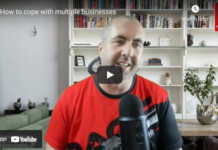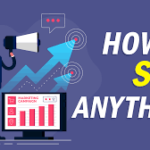- Put the focus on the buyer. Do you have a friend or family member who dominates every conversation by talking about themselves? They likely aren’t your favorite person to talk to, and the same applies to buyers. When salespeople talk too much about their companies or offerings, prospects may find it obnoxious and irrelevant.
To be successful in sales, it’s essential to always make the conversation about the buyer. Every email, voicemail, demo, and meeting should have a buyer-centric focus. Continuously ask yourself, “What’s the relevance to this particular prospect?” and tailor each interaction accordingly.
- Do your research. To earn a buyer’s time and interest in your product, you first need to invest time in understanding them. With the vast amount of information available online, there’s no excuse for reaching out to a buyer without prior knowledge of their business and interests.
Researching a prospect doesn’t have to take a lot of time. Depending on your sales cycle, as little as five to ten minutes per prospect may suffice. Utilize social media, press releases, company financial statements, and Google to gain insight on the prospect and their business.
- Build a connection first. When a customer enters a store, the salesperson doesn’t immediately ask them to buy something. They take the time to build a connection by asking how the customer is doing and what brings them into the store. The same approach should be taken when conducting B2B outreach. Use the research you’ve gathered to initiate a conversation that is personalized and relevant to the prospect.
The key is to genuinely get to know the prospect before delving into your offering and why they should choose you over your competitors. Remember that we’re all human
- Lead with value. When engaging with potential buyers, it’s important to focus on their needs and concerns rather than solely promoting your product or service. Instead of jumping into a sales pitch, offer valuable insights or solutions that can help them address their issues.
Consider sending them relevant industry information, a breakdown of a product’s features, or a piece of content that addresses their specific pain points. This approach positions you as a trusted advisor rather than just a salesperson looking to make a sale.
Pro tip: Prepare templates for common questions or concerns that buyers may have, so you can quickly respond with relevant information.
- Ask questions and listen actively. Effective selling requires a deep understanding of the buyer’s needs and concerns. Asking thoughtful questions and actively listening to their responses is crucial in uncovering these insights.
Prepare a list of open-ended questions that will help you gain a better understanding of the buyer’s situation, such as “How did this issue come about?” or “What are the most important considerations for you in a solution?”.
Be curious and adapt your questioning based on the buyer’s responses. And most importantly, listen actively and reflect back what you have heard to ensure understanding.
Pro tip: Utilize a CRM system to track and store this information for future reference and to keep your team informed.
- Leverage psychology. Understanding basic psychological principles can help you effectively communicate and connect with buyers. For example, the Anchoring effect highlights the importance of providing initial information that sets the standard for further discussions. The Decoy effect can be used to guide buyers towards a preferred option. And the Loss aversion principle highlights the power of emphasizing what a buyer stands to lose if they do not take action.
- Tailor your approach to their personality. When it comes to selling, it’s important to bring your own unique personality to the table. However, it’s also crucial to pay attention to your prospect’s personality and adjust your approach accordingly. Our personal attributes play a role in how we prefer to be sold to and what information we prioritize.
Here’s a brief overview of the four main personality types and their preferences:
- Drivers: Results-oriented and focused on the bottom line.
- Amiables: Creative and interested in big-picture ideas.
- Expressives: People-oriented and interested in how ideas impact others.
- Analyticals: Fact- and data-driven.
Once you understand which category your prospect falls into, tailor your messaging and presentation to align with their preferences and priorities.
- Tap into their emotions. There’s no such thing as a purely rational decision. Our emotions always play a role in how we process information and make choices. Salespeople who only appeal to their buyers’ logic are missing out on a powerful tool.
Every sales message, presentation, and meeting should address the prospect’s emotions as well as their rational mind. Sales expert Geoffrey James suggests tapping into emotions such as greed, fear, altruism, envy, pride, and shame. However, be careful not to overdo it and try to evoke all of these feelings at once. Instead, choose one or two that resonate with your prospect and subtly incorporate them into your messaging.
- Remember that you’re selling to a person. When you’re sending countless outreach emails and voicemails, it’s easy to forget that leads are people. But they are, and they want to be treated as such. Use yourself as a test – would you appreciate receiving this email or voicemail? If not, your buyer probably won’t either.
While it’s important to be professional in sales, it’s also important to be personable. Buyers have lives outside of work and passions that have nothing to do with their jobs. Building real rapport with your prospects means allowing the conversation to drift to the personal occasionally. It doesn’t have to be all business all the time.

















